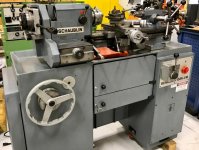JHOLLAND1
Titanium
- Joined
- Oct 8, 2005
- Location
- western washington state
Follow along with the video below to see how to install our site as a web app on your home screen.
Note: This feature may not be available in some browsers.


This machine really is prestine but as Milacron says ... like but IMHO not as good as the HLV-EM.
The taper is unique to Hardinge.....for typical chuck counterclockwise rotation, you simply line up the chuck key with slot in the spindle taper, slide on the chuck and rotate it clockwise a bit to set the key in the perdendicular slot further up the main slot. Although I've never had one come loose unexpectedly, obviously things like tappping would be better done using the integral 5C collet taper.i wonder what spindle-nose taper the HVL has. Does not look like a camlock. Is machine frame (were the bed is mounted on) made of steel-plate?

I have a pretty good idea of the pluses and minuses (and there are plenty) of the machine
I would like to see your list....

Same with the Hardinge. Hardinge is either HLV-TFB (no thread box), HLV-H (quick change inch threads, metric optional via change gears...by far the most common Hardinge)These differences only affect the threading department, since turning feeds are obtained via an infinitely adjustable DC motor on both longitudinal and transversal.
I wonder is any Schaublin lathe model has ever been copied by the Taiwanese ? I don't recall ever seeing an example of such.

OK, I get the humor but what you describe is not a "copy" at all. I mean a Taiwanese lathe that at at 8 feet away looks identical to what it is trying to be.Oh, but we have! Even Hoorer Fright sells some.
Problem is, they are seriously BAD copies, as they haven't yet twigged to the fact that just tossing "round stuff" and scrap iron into a cement mixer, decanting it into a paint vat ten minutes later, spraying it with rancid Soya bean oil, and shipping it just - somehow - doesn't quite get the same results..
.
But Schaublin made that easier when they departed curves for flat, squarish shapes. LeBlond Regal or a Colchester Triumph 2000 ... Mori Seiki? Hwacheon, Webb, Cadillac.. any "Taiwanese Generic" may be the better examples.OK, I get the humor but what you describe is not a "copy" at all. I mean a Taiwanese lathe that at at 8 feet away looks identical to what it is trying to be.
All I can say is you have a way looser definition of the word "copy" than I do, and I can tell most any lathe from 8 feet away...even whether it's a Feeler or Acra HLV-H copy if the labels and original paint are still in place.But Schaublin made that easier when they departed curves for flat, squarish shapes. LeBlond Regal or a Colchester Triumph 2000 ... Mori Seiki? Hwacheon, Webb, Cadillac.. any "Taiwanese Generic" may be the better examples.
Monarch, Rivett, Hendey, ATW, DS&G, earlier Smart & Brown .... Hardinge.. Wade, Elgin, Ames, Stark.. the older Schaublins and the smaller Schaublins... all had some form of curves that were far the more distinctive, one from the next.
Once the HS goes flat and angular, spaces are filled with knobs, buttons, and labels? They start to ALL look much alike from 8 feet away.
All I can say is you have a way looser definition of the word "copy" than I do, and I can tell most any lathe from 8 feet away...even whether it's a Feeler or Acra HLV-H copy if the labels and original paint are still in place.
(John Dunne)Beware the fury of a patient man.

I would like to see your list....


Can't speak for the US but in Europe, Franz Singer would be a good start looking for a MK2 test bar. Have a look here.Particularly intriguing was the part where the operator put some type of test bar into the tailstock and checked it with the indicator. Where does one get such a test bar? I have a Schaublin 102N tailstock that needs alignment and it seems that would be a useful tool to determine how far off it is.
I have a W25 star wheel tailstock for my 102N and it is very useful. Fantastic for drilling. Also unique in that you can put a lathe chuck on the tailstock. Sometimes that comes in handy to line a part up. AFAIK the 102N star wheel has no reduction gears.

Notice
This website or its third-party tools process personal data (e.g. browsing data or IP addresses) and use cookies or other identifiers, which are necessary for its functioning and required to achieve the purposes illustrated in the cookie policy. To learn more, please refer to the cookie policy. In case of sale of your personal information, you may opt out by sending us an email via our Contact Us page. To find out more about the categories of personal information collected and the purposes for which such information will be used, please refer to our privacy policy. You accept the use of cookies or other identifiers by closing or dismissing this notice, by scrolling this page, by clicking a link or button or by continuing to browse otherwise.
